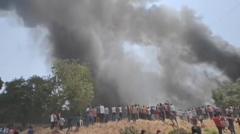

The day began like any other at the Sardar Vallabhbhai Patel International Airport in Ahmedabad, India. Air India flight AI171, a Boeing 787-8 Dreamliner, was preparing for its scheduled departure to London Gatwick. On board were 242 passengers and crew, a mix of Indian, British, Portuguese, and Canadian nationals, all with their own stories and destinations in mind.
At 1:39 PM local time (08:09 GMT), the aircraft, under the command of pilot Sumeet Sabharwal with 8,200 hours of flying experience and co-pilot Clive Kundar with 1,100 hours, commenced its takeoff roll. The weather was hot, a factor that would later be considered in the investigation, potentially affecting the air density and the aircraft's performance.
Barely a minute into the flight, disaster struck. The Dreamliner, struggling to gain altitude, reached a mere 625 feet (190 meters) before its ascent faltered. According to Flightradar24, the signal from the aircraft was lost almost immediately after takeoff. The pilots radioed a mayday call, signaling distress to air traffic control. However, communication was cut short.
The aircraft plummeted back to earth, crashing into a densely populated residential area of Meghani Nagar, approximately 5 kilometers from the airport. The impact was devastating. The plane struck a building used as a doctors' hostel at the Byramjee Jeejeebhoy Medical College and Civil Hospital. It was lunch break, and many students were in the dining hall when the plane tore through the roof.
The crash ignited a massive explosion, sending a towering plume of smoke visible from miles away. Rescue efforts began immediately, but the scene was one of utter devastation. Initial reports suggested no survivors. However, amidst the wreckage, a miracle: Vishwashkumar Ramesh, a 45-year-old British national, was found alive in seat 11A.
Air India confirmed the tragic toll: 241 passengers and crew had perished. In addition to the casualties on board, at least eight people on the ground, including four medical students, lost their lives. The news sent shockwaves across India and the world.
As the day wore on, details of the victims began to emerge. Among them was Vijay Rupani, the former Chief Minister of Gujarat, a prominent figure in Indian politics. Families mourned the loss of loved ones, including the Nanabawa family from Gloucester, England, and Renjitha Gopakumaran Nair, a nurse returning home to India.
The Indian government launched a full-scale investigation into the crash. The Aircraft Accident Investigation Bureau (AAIB), with assistance from the U.S. National Transportation Safety Board (NTSB) and British investigators, began the painstaking task of piecing together what went wrong. The aircraft's black box, containing the flight data recorder and cockpit voice recorder, was recovered from the rooftop of the B.J. Medical College hostel mess building.
India's aviation regulator ordered safety checks on Air India's entire Boeing 787 fleet as a preventative measure. Boeing issued a statement offering support to Air India and expressing condolences to the families of the victims.
The sole survivor, Vishwashkumar Ramesh, was hailed as a miracle. From his hospital bed, he recounted his unbelievable escape, saying he managed to unfasten his seatbelt and exit the plane amidst the chaos.
The crash of Air India flight AI171 marked one of the darkest days in Indian aviation history. The investigation into the cause of the disaster is ongoing, with the world awaiting answers.